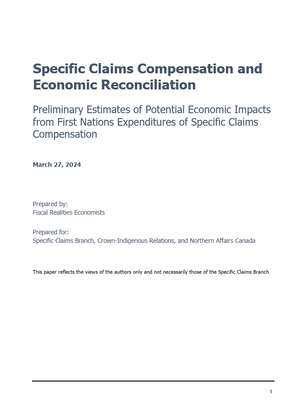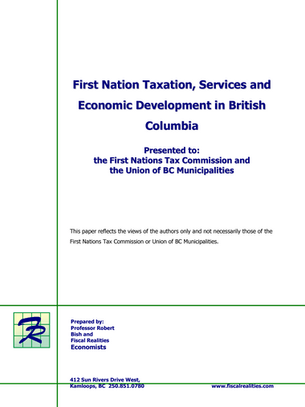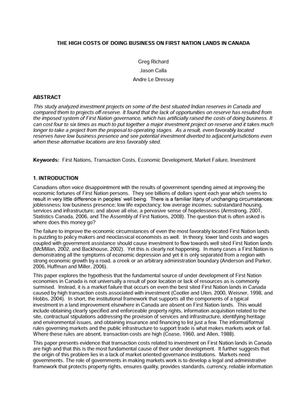
Fiscal Realities is a unique company, founded to support Indigenous development in Canada by providing a wide range of services to First Nation clients, public organizations, and research institutions. Our work focusses on two core areas: Innovative economic and fiscal research to support First Nation investment climates, and capacity development and implementation support for First Nations seeking to accelerate economic development on their lands.
What We're Working On
Specific Claims Compensation and Economic Reconciliation: Phase II – Doig River First Nation and Chippewas of the Thames First Nation: Case Studies on the Economic Impacts of Specific Claims Settlements. Ongoing work in 2025. Being Prepared for Specific Claims Branch, Crown-Indigenous Relations and Northern Affairs Canada.
Policy Work Supporting Asset Management Standards: Ongoing work in 2025. Being Prepared for the Technical Team of the First Nations Infrastructure Institute.
Unlocking Economic Growth: Lessons from High-Performing First Nations Under the First Nations Fiscal Management Act. Fiscal Realities Economists. 2025. Prepared for the First Nations Tax Commission.
Ch'íyáqtel First Nation Case Study: Implementing the FMA-FA Economic Theory for Self-Determination. Fiscal Realities Economists. 2025. Prepared for the First Nations Tax Commission.
Fiscal Relations for a Third Order of Government and Reconciliation. Fiscal Realities Economists. 2025. Prepared for the First Nations Tax Commission.
A Proposed Mathematical Framework to Speed Up First Nation Economic Self-Determination. Fiscal Realities Economists. 2025. Prepared for the First Nations Tax Commission.
Previous Work
Unlocking First Nation Wealth: Past efforts and future opportunities. Le Dressay, A. 2016. In T. L. Anderson (Ed.) Unlocking the Wealth of Indian Nations, Rowman & Littlefield.
Moving at the Speed of Business: A Possible Path to First Nation Prosperity Starts with Efficiency; Le Dressay, Lavallee, Reeves. Oct 2024. Journal of Aboriginal Economic Development, Vol 14 No 2.
Available at: https://jaed.ca/index.php/jaed/article/view/478/477
Making Markets Work on First Nations Lands: The Role of the Land Title System in Reducing Transaction Costs. Apr 2009. Prepared for the First Nations Tax Commission.
The Aboriginal Resource Tax: Closing the Infrastructure Gap. Richard, Greg. Canadian Federalism and Infrastructure. Institute of Intergovernmental Relations. 2015. Available at: https://www.queensu.ca/iigr/sites/iirwww/files/uploaded_files/PDF%20Publications/SOTF%202015%20book.pdf
The Business Case for a New First Nations Infrastructure Institution. Mar 2017. Prepared for the First Nations Tax Commission.
Specific Claims Compensation and Economic Reconciliation: Preliminary Estimates of Potential Economic Impact from First Nations Expenditures of Specific Claims Compensation. Mar 2024. Prepared for Specific Claims Branch, CIRNAC.
Available at: https://www.niedb-cndea.ca/wp-content/uploads/2025/01/Fiscal-Realities-Specific-Claims-Compensation-and-Economic-Reconciliation.pdf
Expanding Commercial Activity – Reducing the Costs of Doing Business on First Nations’ Lands. Fiscal Realities Economists. 1999. Presented to the Indian Taxation Advisory Board and Department of Indian Affairs and Northern Development (INAC).
Preliminary Estimates of Economic and Fiscal Impacts Generated by Off Reserve Spending by Roseau River Households and by Roseau River Anishinabe First Nation. May 2025. Prepared for Roseau River Anishinabe First Nation under contract with the First Nations Tax Commission.
Evolving First Nations Service Populations: Challenges, Impacts & Implications. Fiscal Realities Economists. 2018. Prepared for Assembly of First Nations & Department of Indigenous Services Canada.
An Analysis of the Federal Carbon Pricing Backstop on First Nations Households. Mar 2018. Prepared for Indigenous and Northern Affairs Canada.

Innovative Tools
Building a Sustainable and Resilient Indigenous Economy (Game) – A fun, interactive, and iterative learning game developed for the Tulo Centre of Indigenous Economics. Players are required to make a series of strategic choices with the objective of creating an Indigenous economy that is sustainable and resilient to economic shocks. The game supports learning and application in both Canadian and U.S. Indigenous contexts. Visit app.tulo.ca to play.
Tulo Centre’s Expected Impacts Model – The model, developed for the Tulo Centre of Indigenous Economics, assists users in generating preliminary estimates of expected impacts in order to support improved decision-making, better project evaluation, and enhanced communications. The model estimates the direct and indirect economic and fiscal impacts that could be generated by various investments within Indigenous territories or near Indigenous populations. V
ISC’s Potential Economic Impact Estimator App – The app, developed for the Lands and Economic Development sector of Indigenous Services Canada, helps federal government staff to easily produce estimates of potential economic impacts (jobs, labour income, gross domestic product) generated by proposed projects. The tool can be used to quantitatively inform economic cases, evaluate competing investment options, compare scenarios, and estimate opportunity costs of project delay, supporting optimal prioritization of federal investments.
Service Tax Rate Calculator – Developed for the First Nations Tax Commission, the calculator helps FNTC staff to support First Nations administrators to determine Service Tax rates for planned infrastructure projects. The calculator also informs decision-making around the ideal basis for a Service Tax.
Infrastructure Financial Model (in development) – The objective of the model, currently being developed for the First Nations Infrastructure Institute, is to assist FNII staff and First Nations administrators in the development of financial models for infrastructure projects that are sustainable. The model helps account for all whole-of-life costs, assists in the fair and equitable allocation of costs among groups benefiting from the service, and is capable of incorporating numerous funding sources and revenue streams.
Building a Sustainable and Resilient Indigenous Economy 2 (Game in Development) – This immersive simulation builds on the original 'Building a Sustainable and Resilient Indigenous Economy Game' developed for the Tulo Centre of Indigenous Economics. While players still make a series of strategic choices to create a sustainable and resilient economy, this enhanced version introduces the ability to load realistic community conditions, navigate cost and time constraints, and plan across short-, medium-, and long-term horizons.




















